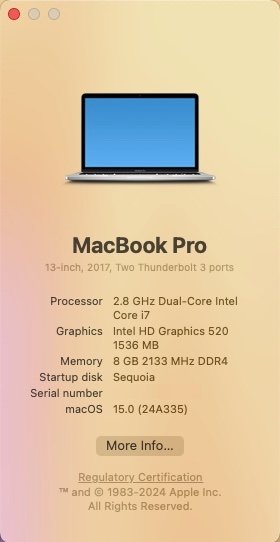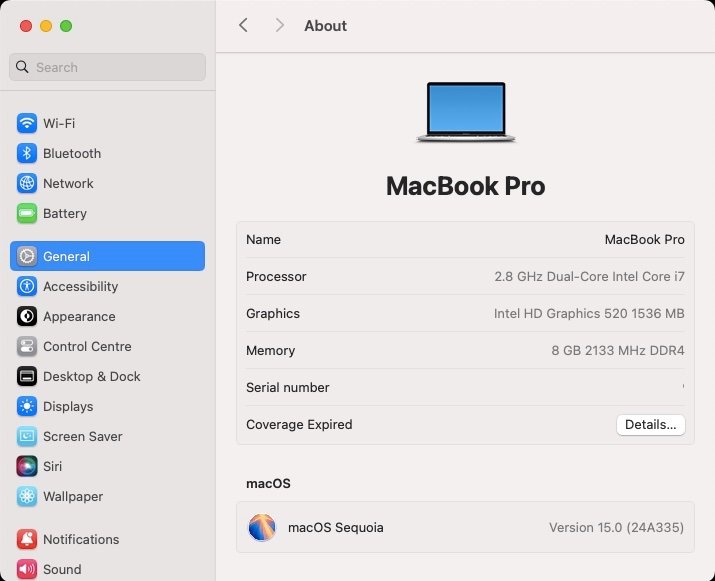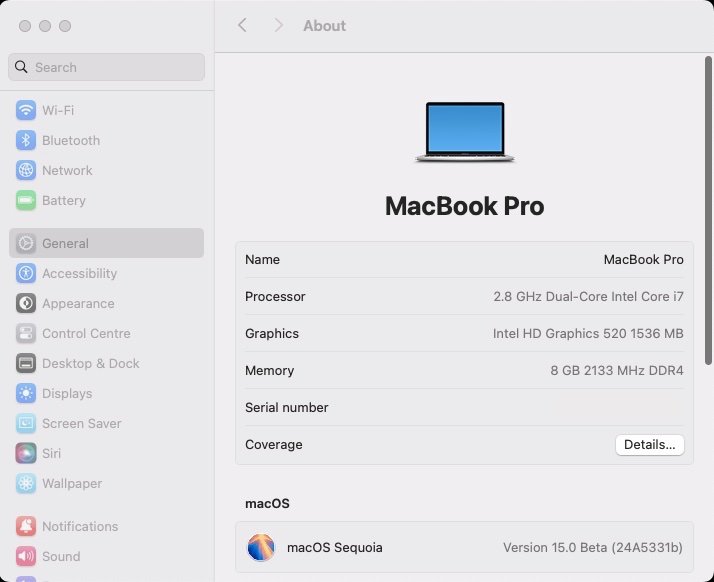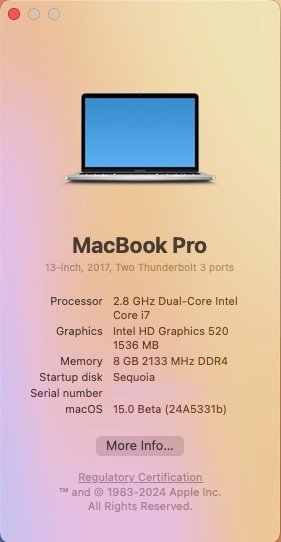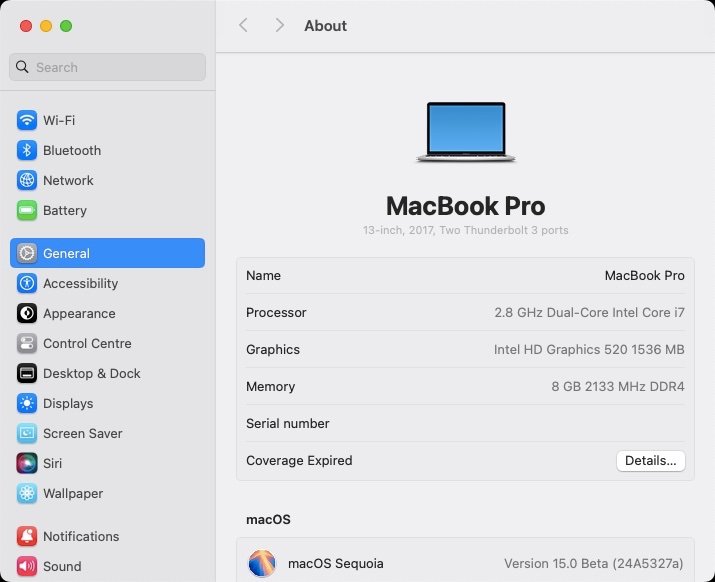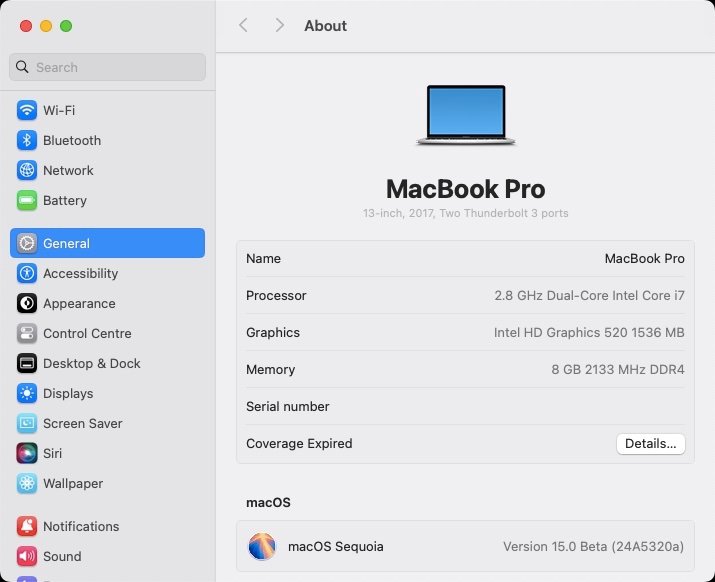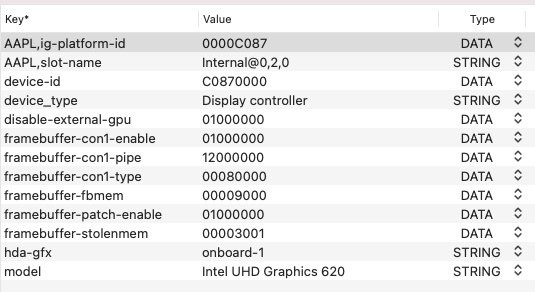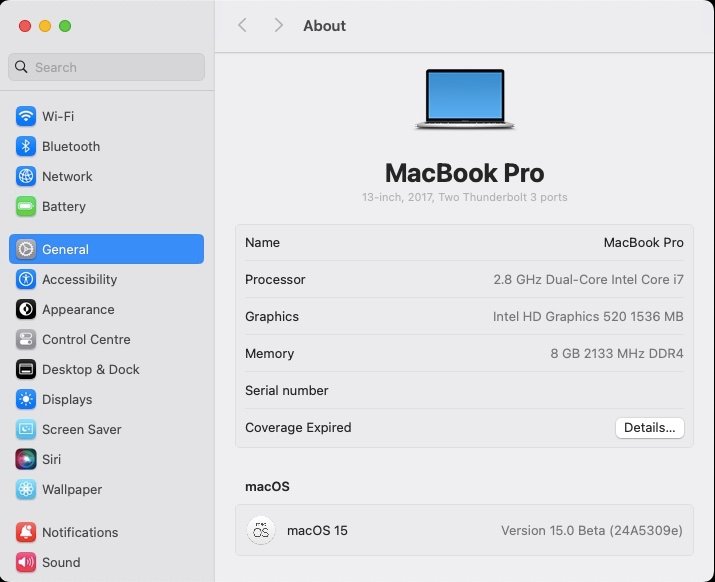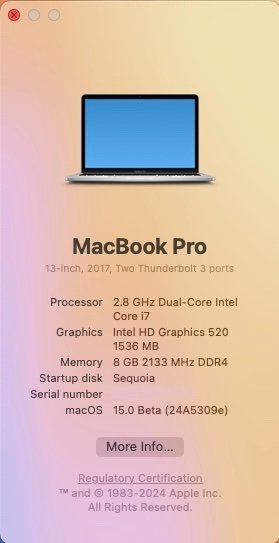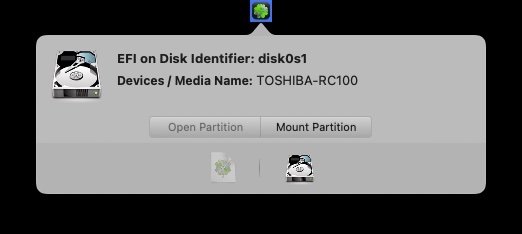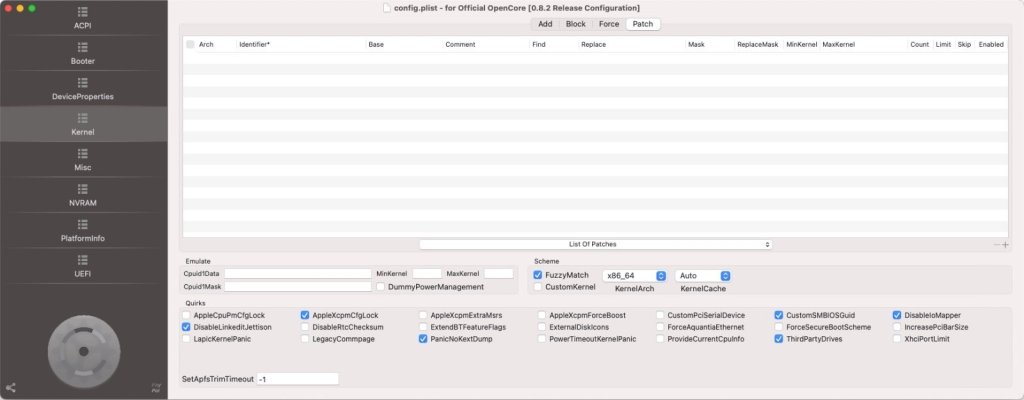-
Posts
10069 -
Joined
-
Last visited
-
Days Won
569
Content Type
Profiles
Articles, News and Tips
Forums
Everything posted by Hervé
-
Sonoma dropped support for all remaining Broadcom "legacy" cards that were supported up to Ventura, this including those based on BCM4360 chipset family. See our 2023 home page articles + Articles/News/Tech/Our Picks threads + Wireless cards inventory about this. https://osxlatitude.com/forums/topic/18228-macos-sonoma-140-beta-1-early-feedback-and-findings https://osxlatitude.com/forums/topic/19519-macos-sonoma-is-out https://osxlatitude.com/forums/topic/20369-support-for-broadcom-wireless-cards-in-sonoma-later-clover-and-opencore https://osxlatitude.com/forums/topic/19730-wifi-in-sonomasequoia-patching-for-legacy-broadcom-wireless-cards/ https://osxlatitude.com/forums/topic/11138-inventory-of-supportedunsupported-wireless-cards-2-sierra-ventura-beyond Forum offers a search facility in top right corner, don't hesitate to use it before posting as stated in our posted rules. Thank you.
-

Dell Latitude 5290: screen resolution issue with USB-c output
Hervé replied to pulleyluke's topic in 5000 Series
Seems more to be an issue with the USB-c output. Post an IOReg with Dock plugged in and screen set to 1080p + screen set to 1440p. -
Released September 16th, 2024. Build 23H124. Bug fixes ans security update. Safe to install on our Hackintosh platforms. Also released on September 16th: macOS Ventura Security Update 13.7 (Build 22H123) View full article
-
Released Sep. 16th, 2024. Version 15.0, build 24A335 (same as RC published Sep. 10th). Sequoia drops official support for Amber Lake MacBook Air8,1/8,2 thereby raising the minimum MacBook Air platform to final 2020 Ice Lake-based MBA9,1. The rest of the supported platforms remain identical to Sonoma. Support for Kaby Lake graphics remain provided with all KBL kexts still present so good news to all owners of Skylake laptops who will all be able to run Sequoia with full acceleration through the SKL graphics patch required since Ventura. For other iGPUs, patches are available through OCLP tool to regain graphics acceleration. Officially supported Intel platforms are now limited to : iMac19,x (8th gen. Coffee Lake) iMac20,x (10th gen. Comet Lake) iMacPro1,1 (Skylake Xeon) MacBookPro15,x (8th gen. Coffee Lake) MacBookPro16,x (9th gen. Coffee Lake and 10th gen Ice Lake) MacBookAir9,1 (10th gen. Ice Lake) Macmini8,1 (8th gen Coffee Lake) MacPro7,1 (Cacade Lake) With Sequoia, Apple introduced artificial intelligence features that are only available to Apple Silicon models. Intel platforms are not compatible with these. NB: macOS Monterey is now officially unsupported. View full article
-
Released September 9th, 2024. Build 24A335. Smooth update on Hackintosh, as usual. OCLP root patching required afterwards, also as usual. Same Clover r5159 setup for my Dell Latitude E7270 as used with initial beta3 version and posted here.
-
There is substantial documentation on the Dortania site. Failing that, you may opt for a Clover classic installation on which you'll apply OCLP patching; that's what I do with my unsupported laptops.
-
For Sonoma, it's exactly the same as for Ventura which dropped official support for Haswell platforms; as such, no native support for Haswell graphics HD4400/4600. In addition, Sonoma dropped support for legacy Broadcom wireless cards. See our previous communications on these matters. I would expect there are existing threads about installing/running Ventura and/or Sonoma on Haswell laptops, whether Dell or otherwise. https://osxlatitude.com/forums/topic/17636-macos-ventura-is-out https://osxlatitude.com/forums/topic/18228-macos-sonoma-140-beta-1-early-feedback-and-findings https://osxlatitude.com/forums/topic/19456-oclp-patcher-support-for-legacy-broadcom-wireless-cards-in-sonoma https://osxlatitude.com/forums/topic/19519-macos-sonoma-is-out https://osxlatitude.com/forums/topic/20304-macos-sonoma-144-update-is-out https://osxlatitude.com/forums/topic/19730-wifi-in-sonoma-patching-for-legacy-broadcom-wireless-cards/ OCLP brings everything back to life: graphics acceleration and wireless (provided you have the required card).
-
Released August 28th, 2024. Build 24A5331b. Smooth update on Hackintosh, as usual. OCLP root patching required afterwards, also as usual. Same Clover r5159 setup for my Dell Latitude E7270 as used with initial beta3 version and posted here.
-
Released August 20th, 2024. Build 24A5327a. Smooth update on Hackintosh, as usual. OCLP root patching required afterwards, also as usual. Same Clover r5159 setup for my Dell Latitude E7270 as used with initial beta3 version and posted here.
-
No support for SKL graphics in Sonoma so no point in trying/using framebuffer 0x19120000. That's dead in the water... The thing is that Desktop HD530 tends to be difficult to get properly supported in macOS. You may have to experiment with other KBL framebuffer layouts/device ids. You got the link for the Whatevergreen user manual. Alternatively a cheap AMD RX560 or WX4100 graphics card (< $100/£100/100€) will work OOB.
-
Hello, your graphics settings are inadequate. You need to fully fake KBL graphics to have any hope of graphics acceleration in Sonoma. Injecting a KBL framebuffer layout is one thing, you also need to fake a KBL iGPU device id. Try these settings instead: AAPL,ig-platform-id 00001259 DATA device-id 12590000 DATA framebuffer-patch-enable 1 NUMBER framebuffer-fbmem 00003001 DATA framebuffer-stolemem 00009000 DATA framebuffer-con1-enable 1 NUMBER framebuffer-con1-type 00080000 DATA If that does not provide you with graphic acceleration, experiment with the various KBL frame buffer layout ids and iGPU device ids as documented in the WEG User Manual. Make sure you use the latest version of Whatevergreen kext.
-

Latitude 5310 KP on sleep (Sleep Wake Failure in EFI)
Hervé replied to scram69's topic in 5000 Series
No, they don't have any issue on the matter; they just don't support this, even in other OS like Windows. The only thing you can wake through keyboard and touchpad is the screen. -

Latitude 5310 KP on sleep (Sleep Wake Failure in EFI)
Hervé replied to scram69's topic in 5000 Series
Afaik, that's pretty standard on Hackintosh laptops and most certainly on all the Dell ones I've had (and I've had a few...). -
Released August 12th, 2024. Build 24A5320a. Smooth update on Hackintosh, as usual. OCLP root patching required afterwards, also as usual. Same Clover r5159 setup for my Dell Latitude E7270 as used with initial beta3 version and posted here. Good news: issue of mounting partitions (such as EFI partition for instance) encountered with beta 5 is sorted; everything back to the norm.
-
Hence why I said: "(config file + ACPI folder + kext folder, rest not required)"... This being said, looking at your setup: make sure you update your add-on kexts to latest version your graphics config appears too complex and incorrect to me. I recommend you stick to just this: In my pre-Big Sur days, I was using these KBL graphics settings my 7490: AAPL,ig-platform-id 00001659 DATA device-id 16590000 DATA Not your ABL settings. I think I also had far less patched ACPI tables injected. Check your quirks settings.
-
Full hardware specs? Zipped copy of your EFI (config file + ACPI folder + kext folder, rest not required)? Verbose output/screenshot of last info before boot loop?
-
Yes, it's just one of those little packaged scripts from chris1111 which basically does what is described above after it was updated for Sequoia. Frankly, no need of a 25MB package to mount the EFI partition...
-
Released August 5th, 2024. Build 24A5309e. Smooth update on Hackintosh, as usual. OCLP root patching required afterwards, also as usual. Same Clover r5159 setup for my Dell Latitude E7270 as used with initial beta3 version and posted here. Post-install issue: As mentioned on other Hackintosh forums, after this update, the EFI partition hosting the bootloader setup no longer mounts properly using tools such a CloverConfigurator, OpenCoreConfigurator, etc. or the line command: sudo diskutil mount <disk id> where <disk id> is the disk reference of the EFI partition; for instance disk0s1. The command executes with apparent success but no EFI icon on the desktop and nothing in mounting point directory /Volumes/EFI which is just empty. admin@macbook-pro ~ % ls -la /Volumes/EFI total 2 drwx------@ 1 admin staff 0 Jan 1 1970 . drwxr-xr-x 6 root wheel 192 Aug 6 11:58 .. A workaround has been posted which consists of manually recreating the directory /Volume/EFI as a mounting point and then mount the EFI partition on it. This can be done as follows: 1) Identify EFI partition disk id: admin@macbook-pro ~ % sudo diskutil list /dev/disk0 (internal, physical): #: TYPE NAME SIZE IDENTIFIER 0: GUID_partition_scheme *240.1 GB disk0 1: EFI EFI 209.7 MB disk0s1 <-- This is the EFI partition disk reference/id 2: Apple_APFS Container disk2 119.9 GB disk0s2 3: Apple_APFS Container disk1 120.0 GB disk0s3 [...] 2) If you've already attempted to mount the partition, unmount it, otherwise proceed directly to step #3 : admin@macbook-pro ~ % sudo diskutil unmount <disk id> (for instance disk0s1) This will remove the /Volumes/EFI mounting point. 3) Create EFI volume manually as mounting point: admin@macbook-pro ~ % sudo mkdir /Volumes/EFI 4) mount EFI partition on it: admin@macbook-pro ~ % sudo mount -t msdos /dev/disk0s1 /Volumes/EFI Executing: /usr/bin/kmutil load -p /System/Library/Extensions/msdosfs.kext Your EFI partition will then be mounted and its disk icon will appear on the desktop. Something has clearly changed with this beta 5 update, I suspect something to do with security or Gatekeeper and the mounting tools and/or methods previously used now need to be updated for Sequoia.
-
The "Generic" entry is just a reference, a name that is supported by the kext. The main thing is, of course, to inject your card's vendor and device ids.
-
-> Moving to WWAN hardware support, this is not related to a 7000 series per sé. From memory, the legacyQMI kext in question applied to a specific vanilla kext from an older OS X or macOS version; I'm pretty sure you would need to make it up for your current version, i.e. Big Sur so that it matches the dependancies of the vanilla kext. It's basically just an injector matching the syntax of the vanilla kext of the hosting OS. With Big Sur, Apple introduced some significant changes in the security of the OS and you can no longer (easily) patch kexts in /S/L/E. But you should be able to either make your own injector or -and your may find this easier though the aim is identical- inject/add your patch in FakeSMC or VirtualSMC (see here and you'll find a sample of injection through FakeSMC here). You may also look at these threads and draw your own conclusions: https://osxlatitude.com/forums/topic/12154-help-setting-up-dw5808e-on-e7450-dell https://osxlatitude.com/forums/topic/13027-dell-dw5811e-sierra-wireless-em7455-wwan-not-working Unless you have a dedicated SIM card for mobile computer data, such cellular cards are kind of deprecated today since it's much easier to simply pair a computer to a cell phone through Bluetooth or hook it by USB cable.
-

DELL Optiplex 3040 Mac Os Sonoma which SMBIOS?
Hervé replied to karahanzorbey's topic in Dell Desktops
-> moving to the Dell Desktop section. Re:SMBIOS, see our previous June announcement on the unveiling of Sequoia: https://osxlatitude.com/forums/topic/20327-macos-sequoia-unveiled Then we have a dedicated section about Sequoia beta if need be. If things work as they are and you're happy with them, don't change anything. -
You're not making much effort to try and understand... Anyway, Okay, closing and archiving this thread.
-
Given that you don't seem to be fully familiar with OC config files and manual adjustments, I suggest you experiment with OpenCoreConfigurator (OCC) tool and a blank/empty config file first; then you'll see where such patches go. In fact, I dare suggesting you stick to using such tools.
-
You don't understand. The patches are about IONVMeFamily vanilla kext, not about an add-on kext you inject in your bootloader setup. It's an integral part of macOS, located in /S/L/E. Prefix "com.apple.iokit." should have been enough to suss that out. Looks like you have some reading and learning to do. A hint for eventual future needs: look at kexts info in SysInfo->Software->Extensions. You'll see what we're talking about and why...




